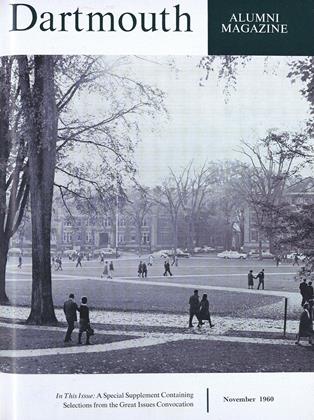By JohnH. Haefner, Harold R. Bruce, and RobertK. Carr '29. Chicago: Scott, Foresman,1960. 679 pp. $4.96.
Based on our past voting performance, neither Mr. Kennedy nor Mr. Nixon will be the numerical favorite of the American electorate on November 8. This distinction will fall upon a third, mythical individual - Mr. Default, or the man who didn't run - due to the startling fact that an estimated 35 to 40 million potential voters will fail to indicate their choice for President of the United States in this year's election.
A variety of factors can be cited in an attempt to minimize this shabby record, among them such very real problems as sectional disenfranchisement of minority groups and technical roadblocks in the form of local residence requirements. Yet, when all is said and done, the basic fact remains that a staggering number of Americans simply do not care enough about their government to take the time and effort to participate in the selection of its leaders.
In seeking a partial explanation for such widespread political apathy, one would do well to look at that standard ingredient of our secondary school curriculum, the high school "civics" course; for the lifeless dissection of governmental "institutions" which all too often has characterized our traditional approach to this subject has served as a promising breeding ground for future political indifference, rather than heightened political interest.
Fortunately, signs of change and progress are on the horizon, as is clearly evident in a superbly attractive new high school textbook, Our Living Government, by Prof. John H. Haefner of the State University of Iowa; Harold R. Bruce, Dartmouth Professor of Government Emeritus and now Visiting Professor of Government at Pomona College; and Robert K. Carr '29, former Professor of Government at Dartmouth and now President of Oberlin College.
As its title implies, this volume attempts to introduce the student to the contemporary realities of American political life through a comprehensive and imaginatively organized treatment of typical material, a lively and concise style of writing, and, above all, a rich and varied utilization of photographs, cartoons, graphs, charts and other visual aids which do much to stimulate the interest of the reader. In addition, the authors have included a number of helpful aids at the beginning and conclusion of each chapter to help the student see where he is going and where he has been.
In short, this is a very welcome addition to the teaching scene. The authors are to be congratulated on making Our Living Government just that.
 View Full Issue
View Full Issue
More From This Issue
-
 Feature
FeatureIt Was A Dartmouth Jinx All the Time
November 1960 By AMOS N. BLANDIN '18 -
 Feature
FeatureA Fulbright Year in France
November 1960 By FRANCIS E. MERRILL '26 -
 Feature
FeatureThe Commitment of Leadership
November 1960 By JOHN SLOAN DICKEY -
 Feature
Feature"The Era of the Shrug"
November 1960 -
 Article
ArticleEvening Assembly
November 1960 -
 Article
ArticleSecond Panel Discussion
November 1960
FRANK SMALL WOOD '51
Books
-
 Books
BooksHAROLD LLOYD'S WORLD OF COMEDY.
OCTOBER 1964 By CLIFF JORDAN '45 -
 Books
BooksALUMNI PUBLICATIONS
April, 1923 By F. E. BROWN. -
 Books
BooksWHAT THE OLD-TIMER SAID: TO THE FELLER FROM DOWN-COUNTRY AND EVEN TO HIS NEIGHBOR—WHEN HE HAD IT COMING
JULY 1971 By JOHN HURD '21 -
 Books
BooksHEMORRHAGE OF LATE PREGNANCY.
January 1957 By JOHN J. BOARDMAN, M.D. -
 Books
BooksLE HIBOU ET LA POUSSIQUETTE.
January 1962 By RICHARD W. MORIN '24 -
 Books
BooksTHE ROMAN CATHOLIC PROBLEM.
October 1954 By WILLIAM KELLEY WRIGHT



